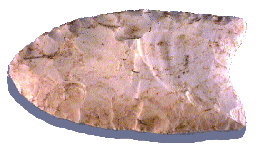
|
Native Americans
in the Warwick Valley |

|
Native Americans
in the Warwick Valley |
| The earliest trace of human activity in the Warwick Valley is that of the nomadic peoples arriving in the area following the retreat of the glaciers. These Paleo-Indians are known by the distinctive shape of their projectile points, the Clovis Point. Some locally found points found near the border of Goshen and Warwick at the Dutchess Quarry Cave site have been dated to around 10,600 B.C. They were found in association with (extinct) caribou and giant beaver bones that could be radio-carbon dated. (see book sources listed below). |

(Photo courtesy of
Lithics-net)
|
|
The Munsees
The tribe living in the area at the time of its colonization by Europeans was the "Minsis". The name is subject to many different spellings in historical documents; the most commonly used at this time is "Munsee". They were part of the "Wolf Clan" of the Leni Lenape or Delaware people, members of the Algonquian language and culture group. The word minsi means "wolf", and this was the most warlike of the Lenape clans, living nearest the Iroquois and acting as a sort of shield for the other clans from the incursions of the Iroquois. Their territory extended from the Catskill mountains to the head waters of the Delaware and Susquehanna rivers, bounded on the east by the Hudson. |